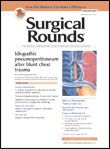Heading Straight Home After Robotic-assisted Hysterectomy
Many gynecologic surgeries that formerly required large incisions and lengthy hospital stays are simpler today due to smaller incisions, less blood loss, and improved mobilization. As a result, same-day discharge after robotic-assisted hysterectomy - an option that only recently became available - now seems possible.

Many gynecologic surgeries that formerly required large incisions and lengthy hospital stays are simpler today due to smaller incisions, less blood loss, and improved mobilization. As a result, same-day discharge after robotic-assisted hysterectomy — an option that only recently became available — now seems possible.
Since 2010, researchers at the Memorial Sloan-Kettering Cancer Center in New York have employed robotic-assisted hysterectomy and allowed same-day discharge. For a study published online April 28, 2014, in Gynecologic Oncology, they reviewed the procedure and cross-referenced several datasets, including the distance between the hospital and patients’ homes, surgical indication, urgent care center (UCC) visits, and readmissions within 30 days of surgery.
According to the study authors, 200 women with a median age 52 were admitted for robotic-assisted hysterectomy with planned same-day discharge. Approximately half of the procedures were simple, while the remainder was complex. The average distance to patients’ homes was 31.5 miles.
Of those patients, 157 women (78%) were discharged on the same day as planned, with most sent home within roughly 5 hours of surgery. Discharge was more likely if the operative time was short, the surgery was completed before 6 PM, or the patient received intraoperative ketorolac. Approximately 5% of the participants required UCC visits, and hospital readmission was necessary in 2.5% of the same-day discharge cases. Among the 43 women who were unable to be discharged on the same day as their surgery, 11.6% made a UCC visit post-discharge.
Professional organizations have yet to develop clear guidelines for successful same-day discharge programs. Memorial Sloan-Kettering credited its success to selecting patients carefully, managing patient expectations with preoperative counseling, following anesthesia protocols for pain and nausea prevention, and ensuring patient access to analgesics. The authors also noted that patients must have help at home with following detailed postoperative instructions. Additionally, if same-day discharge is planned, scheduling the procedure as the first case or earlier in the day is prudent.
The researchers said improvement after robotic-assisted hysterectomy is usually fast and event-free, and since most patients will have no complaints, clinicians must take complaints seriously whenever they are voiced. They concluded that same-day discharge after robotic-assisted hysterectomy for benign and malignant conditions is feasible and safe.
